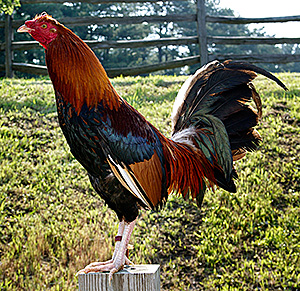Page content
Historic Farming
Livestock - Poultry
Chickens, ducks, geese, and turkeys were kept by even the poorest Virginians, slave or free, for fresh meat and eggs. Feathers were useful in bedding, and goose quills in particular made handy writing utensils. Turkeys could be driven by children through tobacco fields to help control damage caused by the voracious hornworms that constantly attacked the crop. Chesapeake fowl, like other livestock, were of mixed Old World breed heritage. Collectively, chickens were referred to as dunghill fowl.
It is believed that turkeys, ducks, chickens, and geese were kept together in one mixed species flock. They ranged around the domestic yard, nesting their eggs where convenient and seeking shelter when necessary. Poultry houses are seldom listed on estate inventories.
Cockfighting, like horse racing, provided colonials with an opportunity for socializing and gambling. Fighting cocks, like racehorses, received unusual care and attention, but unlike the racehorse, the fighting cock rarely lived to compete another day if unsuccessful.

